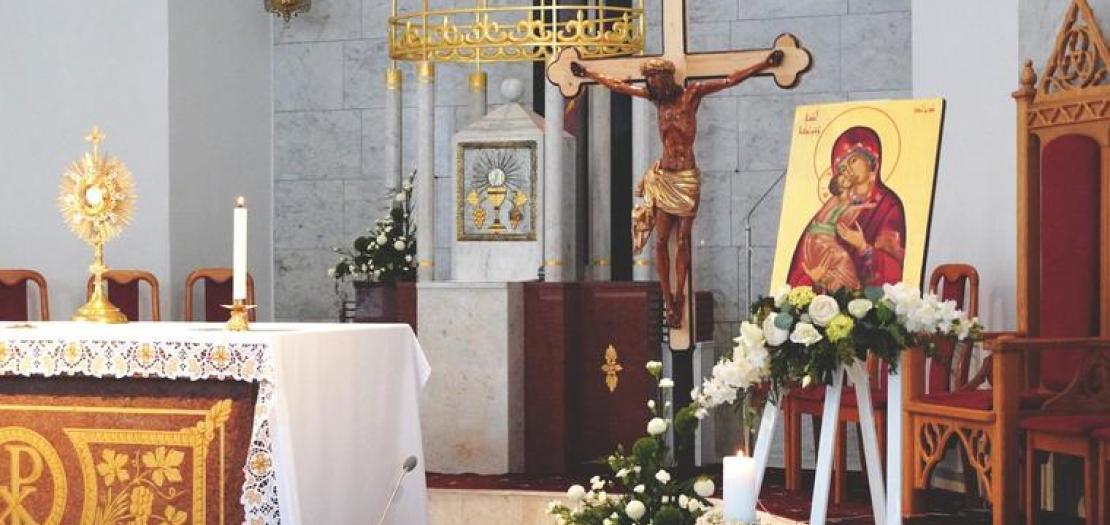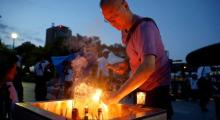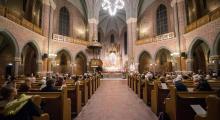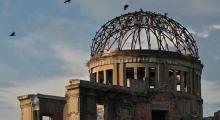Issued by the Catholic Center for Studies and Media - Jordan. Editor-in-chief Fr. Rif'at Bader - موقع أبونا abouna.org

A Marian shrine dedicated to persecuted Christians was inaugurated at the Church of Our Mother of Perpetual Help in Kazakhstan’s capital, Astana, June 20. It is the sixth prayer center established by the U.S.-based organization Nasarean.org — and the first in Central Asia.
Located in a country marked by decades of religious repression, the shrine — established with the blessing of Archbishop Tomasz Peta and supported by Auxiliary Bishop Athanasius Schneider — joins a growing international network centered around the icon of Mary, Mother of Persecuted Christians.
In his homily for the shrine's inauguration on Friday, June 20, Bishop Schneider recalled the words of St. John Paul II on his visit to Astana in 2001, when he spoke of the “unspeakable trials” of those who suffered “because they chose not to renounce their faith.”
Launched in 2018, this initiative invites dioceses worldwide to host an icon painted by Lebanese Melkite nun Souraya Herro, inspired by the traditional image of “Mother of Tenderness.” The icon features the Aramaic inscription “Mother of the Persecuted,” linking the modern suffering Church to the language of Christ and the early martyrs.
Each shrine is inaugurated with episcopal blessing and becomes a spiritual home for prayer and solidarity with Christians facing violence, discrimination, or exile across the world.
Kazakhstan--a vast, sparsely populated nation bordered by Russia and China--carries particular symbolic weight within this project. Under communist rule, it was one of the main sites of the Soviet Gulag system, where millions were imprisoned, including countless clergymen, nuns and lay faithful.
A quiet but enduring witness
From the 1930s onward, entire ethnic groups were forcibly relocated to Kazakhstan, including Germans, Poles, Ukrainians and Balts, many of them Catholic or Orthodox. Religious practice was criminalized. Churches were shuttered or repurposed, and the sacraments were celebrated in secret.
Among those affected was the family of Bishop Schneider, born in 1961 to ethnic German Catholics exiled to the Urals. Raised in the underground Church, he attended clandestine liturgies and lived firsthand the experience of spiritual resistance — a legacy that has shaped his pastoral commitment and motivated his support for the new shrine.
Since gaining independence in 1991, Kazakhstan has officially recognized freedom of religion. In practice, however, that freedom remains tightly regulated. Around 70 per cent of the population is Muslim, with Christians — mostly Russian Orthodox — making up about 26 per cent. Catholics are a small minority but maintain an active presence through schools, parishes and charitable outreach.
In 2022, Pope Francis visited the country to attend the Congress of Leaders of World and Traditional Religions, encouraging religious freedom, interfaith dialogue and peaceful coexistence. His visit was also meant to highlight the quiet but enduring role of the Catholic Church in Central Asia.
Persistent barriers to religious freedom
Despite this openness, Christians in Kazakhstan — especially converts from Islam — continue to face significant challenges. In its 2024 “World Watch List,” Open Doors ranked Kazakhstan 38th among the most difficult places to be Christian, placing it close to other Central Asian nations such as Uzbekistan and Tajikistan.
The association noted that converts endure social and familial rejection, physical abuse, and — in some cases — house arrest or forced marriages. Women are particularly vulnerable in rural areas, facing harassment, violence and even bride kidnapping. Men face government scrutiny, travel restrictions and extortion, especially in business contexts.
.
These dynamics are reinforced by Kazakhstan’s restrictive “Religion Law,” enacted in 2011, which imposes strict registration requirements, limits public worship, and prohibits unregistered religious activity. Open Doors reports that while Russian Orthodox communities are largely spared interference, Catholic and Protestant groups engaging with the broader population are subject to surveillance, raids and legal harassment.
In 2017, the U.S. Commission on International Religious Freedom reported that 20 individuals were imprisoned in Kazakhstan for peacefully expressing their faith. A 2018 report by Norwegian watchdog Forum 18, summarizing 15 years of observation, described the country’s religious-freedom climate as fundamentally repressive despite official rhetoric.
A growing network of prayer
The icon of Mary, Mother of Persecuted Christians has already been installed in five Western cities: New York; London; Stockholm; Clinton, Massachusetts; and Lander, Wyoming. While those locations reflect the West’s growing spiritual indifference, Kazakhstan represents a land where oppression has been lived and remembered — and, for some, continues still.
In 2023, during the inauguration of the Stockholm shrine, Father Benedict Kiely, the founder of Nasarean.org, lamented that many Catholics in the West remain unaware of the scale of Christian persecution worldwide and tend to focus more and more on social or environmental issues. “Scripture specifically tells us that if one part of the Body suffers, all suffer,” he told the Register, underscoring the importance of spiritual solidarity.
Three new shrines are currently in development, as part of Father Kiely’s vision for a truly global chain of intercession — one that connects dioceses across continents through a single image and a single intention: prayer for the persecuted.
In Kazakhstan, where the faith has survived through silence and exile, the installation of the icon restores a memory long confined to the shadows. It honors those who remained faithful in the face of repression and extends the Church’s care to those still bearing the cost of being disciples of Christ — often in obscurity, but no longer alone.







